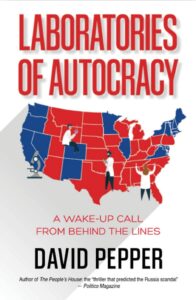One of the pleasures of reading detective novels is getting to know the setting. Sara Paretsky’s detective series, which features V.I. Warshawski, exposes new sides of Chicago. The same is true with Cara Black‘s series, featuring Aimee Leduc, which is set in Paris. Writers like Paretsky and Black blend something close to investigative journalism with first rate sleuthing, resulting in consistently terrific reads.
series, which features V.I. Warshawski, exposes new sides of Chicago. The same is true with Cara Black‘s series, featuring Aimee Leduc, which is set in Paris. Writers like Paretsky and Black blend something close to investigative journalism with first rate sleuthing, resulting in consistently terrific reads.
David Pepper, former elected official and chair of the Ohio Democratic Party, is not quite as skilled a fiction writer as Paretsky or Black. But he is good, and his topics are timely. The protagonist for Pepper’s political thrillers is investigative reporter Jack Sharpe. In The Voter File, for example, Sharpe discovers that the “voter files”—the files kept by both political parties on all voters—have been tampered with in order to throw local elections.
Pepper’s non-fiction book, Laboratories of Autocracy: A Wake-up Call from Behind the Lines, is first rate. It reads more easily than his novels, and the plot, as it were, is much more unsettling. Pepper’s well documented argument is that as a result of a long-term and very strategic campaign at the state level, a number of states currently function as autocratic democracies rather than as representative democracies. In his book, Pepper explains how “minority rule” has come to be the norm, rather than the exception, in states across the U.S. Reading these books helped me get to know the setting of our gerrymandered states.
Minority rule
Pepper explains “minority rule” as a condition where voters in a state show a clear preference for one party in terms of total vote count, yet that party does not win the majority of seats in a statewide election. In Michigan, for example, in 2018, voters voted for Democratic state house candidates by 52% vs 47% for Republican candidates. Yet the Democrats lost seats through redistricting, which resulted in 58 legislative districts favoring Republicans and 52 favoring Democrats. In Pennsylvania, voters chose Democrats over Republicans 55%-44%, yet the legislative district breakdown favored Republicans in 109 districts vs 93 favoring Democrats. In Ohio, voters voted for Republicans 50.5%-49.5%, but redistricting translated that into a 61-38 legislative district Republican-favoring supermajority.
Even in states where majorities of voters favored Democrats, redistricted maps organized those votes in ways that created Republican majorities. One post-2019 study found that almost 60 million Americans live in ‘minority’ rule states. Pepper argues that as a result of extreme gerrymandering, an entire generation of statehouse majorities have never had to win a general election on anything like an even playing field. In this gerrymandered world, there is a strong incentive to please the powers that led to successful gerrymandered districts. There’s little incentive to work across party lines, and very little accountability for serving the general public. Without real elections, there’s no check on the poor performance of those in power.
In an episode of This American Life called “Mapmaker, Mapmaker, Make Me a Map,” Ira Glass tells a related story about state politics. As he notes, “in 2015, voters in Ohio approved a Republican constitutional amendment to end gerrymandering in the state—one of the first of its kind. And then Ohio Republicans drew electoral maps that violated their own constitutional amendment, and those are the ones they’re using in this year’s elections.” The episode reinforces Pepper’s alarm call. Ohio Republicans ultimately refused to follow the directive of the Ohio Supreme Court to create a voting map that fairly represents the electorate. Instead, voting in 2022 is based on a redistricting map that gives Republicans a clear edge. Only seventeen districts in Ohio are “toss-ups” where either a Republican or a Democrat could be elected. All of those seats are currently held by Democrats.
The redistricting process
In theory, the redistricting process is supposed to, as the Pennsylvania General Assembly puts it, create “representative districts, which shall be composed of compact and contiguous territory as nearly equal in population as practicable.” In practice, all too frequently, those tasked with drawing new legislative maps use information about voter preferences, race, and age to maintain their political party’s advantage in elections. Just a week ahead of the November 2022 election, the Associated Press reported that “the majority of House districts aren’t competitive, thanks to a redistricting process that allows state legislatures to draw their own congressional lines if they decide to. Many legislatures draw lines to give advantages to one party or another.”
Prior to reading Pepper’s books, I confess to not paying attention to how my choices as a voter are determined. I recognize the near total domination of a two party system, which stands in contrast to the multi-party democracies around the globe. But I never wondered who determined that I would vote State District 27, or Congressional District 9. Turns out, I’m in good company.
In thirty three states, legislators draw the boundaries for the legislative districts. Seventeen states, including WA State, have a redistricting commission which may be made up of any mix of voters, representatives from both parties, and legislators. Theoretically, redistricting efforts are not supposed to provide an advantage to either political party. And they are supposed to make proportional representation possible for all races, rather than continuing the tradition of privileging white voters.
However, along with other political watchdog organizations, Project FiveThirtyEight reports that,
“there are two other important takeaways from the 2021-22 redistricting cycle.
First, the number of swing seats will continue to decline; the new maps have six fewer highly competitive districts than the old ones.
And second, people of color will remain underrepresented in Congress.”
Weaponizing statehouses
Gerrymandered state legislatures generate autocracy, rather than democracy. One of the most compelling sections in Laboratories of Autocracy is Pepper’s discussion of the American Legislative Exchange Commission, aka ALEC. As many readers know, ALEC emerged in the 1970s to shape conservative battles at the state level, first by opposing abortion and the Equal Rights Amendment, and by focusing on business and regulatory matters.
Pepper describes ALEC’s process for ranking states based on their “economic” outlook: lower taxes are good, caps on public spending are good, laws limiting collective bargaining are good; income taxes are bad, large numbers of public sector workers are bad (evidence that privatization has not made sufficient inroads), a minimum wage above the federal threshold is bad. He characterizes ALEC’s process for generating model legislation as a “bill mill”—similar in character to a puppy mill, focused on short-term profits at the expense of everyone else.
I was equally nauseated and appreciative of Pepper’s blow-by-blow description of how ALEC operates. Legislators pay minimal dues to participate in ALEC; instead they are given corporate scholarships to attend high roller events in attractive destinations, where “experts” help them draft model legislation in line with ALEC’s principles. In the midst of this exposé on what in any other country would be called corruption, Pepper does an ironic riff on the classic Mastercard commercial: “Membership in ALEC? $20,000. Being a private legislator? Priceless!”
A glimmer of hope
In spite of the predictions of a “red tide” sweeping into Congress with the midterms, that didn’t happen. Young people voted in record numbers. Turn out for young voters was around 20% in previous midterms; in this election, in battleground states, turnout was up to around 31%. Election deniers lost races for key state offices in every closely contested state.
The episode on This American Life about gerrymandering in Ohio and the refusal of the Republican legislature to follow the guidance of the Ohio State Supreme Court, ended with a reflection by Jen Miller of the League of Women Voters, the organization that sued the state three times over the antidemocratic maps. “The lesson is that politicians are going to be politicians, and we have to take them out of the equation completely… we’re going to have to have another ballot initiative. It’s going to be hard. It’s going to be expensive. It’s going to take a long time. But if you look around the states and see which places redistricting went well, they were independent, balanced commissions.”
Emily Lardner is a member of the WIP publishing committee.

Be First to Comment